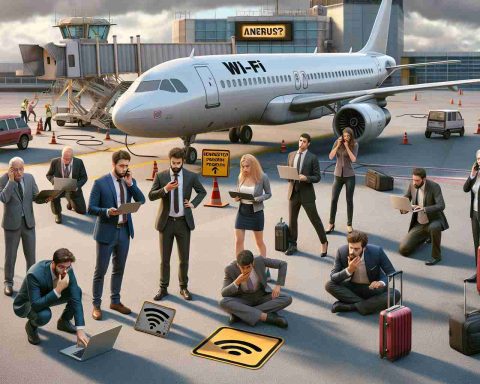- A passenger’s Wi-Fi hotspot named “I have a bomb” caused a serious security concern on an American Airlines flight.
- The incident led to the plane returning to the gate, and authorities conducted thorough luggage and security checks.
- The flight was delayed by three hours but eventually resumed safely without affecting broader airline operations.
- The event highlights the serious implications of pranks perceived as threats in the aviation industry.
- Safety organizations stress that there is no tolerance for jokes about danger in air travel.
- Passengers are reminded of the importance of respecting the shared space and maintaining vigilance for safety.
A ripple of unease swept through the cabin as passengers settled into their seats on a routine American Airlines flight last Friday. The aircraft was poised to soar from Austin, Texas, to Charlotte, North Carolina, when a jarring discovery forced it back to the gate: a passenger’s Wi-Fi hotspot name hinted ominously at disaster.
The words “I have a bomb” flickered on devices, turning a lighthearted prank into a matter of grave concern. Authorities acted swiftly. The plane paused its journey, rolling back to the gate as a wave of blue-uniformed officers boarded. Luggage was thoroughly searched, each overhead compartment scrutinized as a tense silence enveloped the plane.
Passengers spilled out into the bustling Austin-Bergstrom International Airport, funneled back through the rigorous gauntlet of Transportation Security Administration checks. Their journey delayed, the travelers watched as a meticulous sweep ensured their safety.
Though the prank’s intent may have been humor, the consequences were real. The flight finally ascended into the turquoise sky, three hours behind schedule. The ripples of this incident did not, however, extend beyond the affected flight, leaving broader airline operations unscathed.
Such events underscore the thin line between prank and peril in the modern era of aviation. Safety organizations remain unwavering; their message is clear: in air travel, there is no room for jokes about danger.
With nerves settled and skies once more open, the key takeaway resounds: words wield power, and vigilance triumphs in the name of safety. As passengers mindful of the airways, it remains crucial to respect the shared space of the skies.
A Prank Gone Too Far: The Hidden Consequences of Wi-Fi Hoaxes on Flights
Broader Implications of Aviation Security Incidents
The recent incident aboard an American Airlines flight, where a passenger’s Wi-Fi hotspot with a threatening name caused a delay, highlights critical themes within aviation security and society’s broader dependence on digital communication.
# Impact on Passengers and Airlines
1. Emotional Toll on Passengers: Encounters with security threats, however hoaxed, can induce significant stress and anxiety among passengers. This emotional impact can last beyond the immediate situation and deter individuals from flying in the future.
2. Operational Disruptions: Though the incident did not affect broader airline operations, such situations can potentially strain airline resources and lead to cascading delays in tightly scheduled flight operations.
3. Increased Security Protocols: Incidents like these reinforce the need for stringent security protocols, potentially leading to increased security checks and longer boarding times, affecting the passenger experience.
4. Regulatory and Training Measures: Airlines may be prompted to revise training programs for crew members and ground staff to better handle such security scares, simultaneously working with regulatory bodies to enhance safety measures.
# Technological and Societal Considerations
1. Cybersecurity in Aviation: This incident underscores the importance of cybersecurity within aviation. While in this case, a Wi-Fi hotspot was the medium, it serves as a reminder of potential cyber vulnerabilities airlines could face.
2. Public Awareness Campaigns: There is a critical need for increased public awareness regarding the gravity of making threats—even as a joke—especially in sensitive environments like airports and airplanes.
3. Legal Repercussions: Pranks that jeopardize flight safety can lead to significant legal consequences. Passengers involved can face fines or imprisonment, highlighting the legal boundaries that govern aviation security.
# Questions for Future Consideration
1. How can technology be used to prevent such incidents? Technologies like machine learning could potentially identify suspicious activities or behavior patterns before they cause disruptions.
2. What regulatory changes can enhance passenger and crew safety without compromising convenience? The balance between stringent security and customer convenience remains a delicate one that the aviation industry continues to navigate.
3. How can airlines foster a culture of security awareness among passengers? Engagement programs, informative pre-flight briefings, and interactive campaigns could be effective ways to instill a strong security mindset among travelers.
By understanding the nuances and potential dangers inherent in acts often dismissed as pranks, both airlines and passengers can contribute to a safer flying environment.
For those interested in learning more about airline security and potential implications, refer to the following credible sources:
– Federal Aviation Administration
– Transportation Security Administration









